According to a new Public Policy Priorities poll commissioned b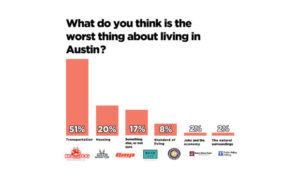 y the Austin Monitor, the worst
y the Austin Monitor, the worst
thing about living in Austin is — by far — transportation. More than half of Austinites (51%) chose transportation, beating out housing (20%) by better than a 2-to-1 margin. More Austinites are frustrated at transportation than they are at all their other concerns combined.
It’s time to do something meaningful to address our frustrations with traffic options and congestion.
Last week I introduced the Smart Corridor Resolution to help kick off the community discussion about our mobility challenges. Our Council and community should have a robust discussion about this city’s mobility needs, and all options should be considered. The Smart Corridor plan, which will decrease traffic congestion, improve transit, increase transportation options, and build safer sidewalks and protected bike paths, should be a part of that discussion which starts on Tuesday at the Mobility Committee’s meeting at City Hall.
The streets in the Smart Corridor plan are the ones we drive on all the time: Airport Boulevard, East Riverside Drive, North and South Lamar, FM969 & MLK, and Burnet. Almost half (49.6%) of Austin’s population lives within two miles of these streets, and they were not built to carry this much traffic. If we can turn these old state highways into Smart Corridors, we’ll be improving traffic congestion in a way that makes transit more effective and attractive and makes biking and walking safer and more convenient.
What makes these roads “Smart Corridors”?
So what would we be doing to these old state highways that would turn them into “Smart Corridors”? Everybody will receive something, so the roads will improve for everyone: pullouts and queue jumps for rapid transit, protected paths for bicycles, sidewalks and safe crosswalks for pedestrians, turn lanes and access management for vehicles, and smart signals that we can time remotely in response to weather, special events such as games letting out, collisions, etc.
Here’s how that would work:
Never get stuck behind a bus again
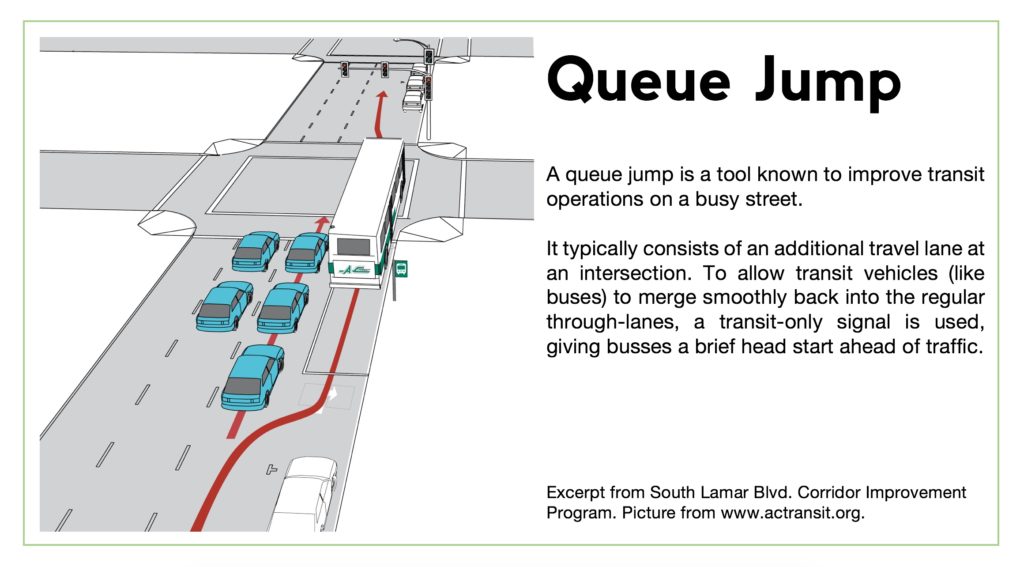 Ever get stuck behind a bus? You won’t on a Smart Corridor because of pullouts. See in the picture above how the bus pulls out of traffic to offload passengers? Buses pull over, and you keep going. It’s that simple.
Ever get stuck behind a bus? You won’t on a Smart Corridor because of pullouts. See in the picture above how the bus pulls out of traffic to offload passengers? Buses pull over, and you keep going. It’s that simple.
Queue jumps are how the bus gets back into the flow of traffic. Special traffic lights give the bus a 10-second head start, giving the bus an advantage over regular traffic that keeps the bus moving, which in turn makes public transit more attractive. This is one example of how we can reduce traffic congestion in a way that helps other forms of transportation, in this case buses.
“Cycle Tracks” – AKA protected bike lanes
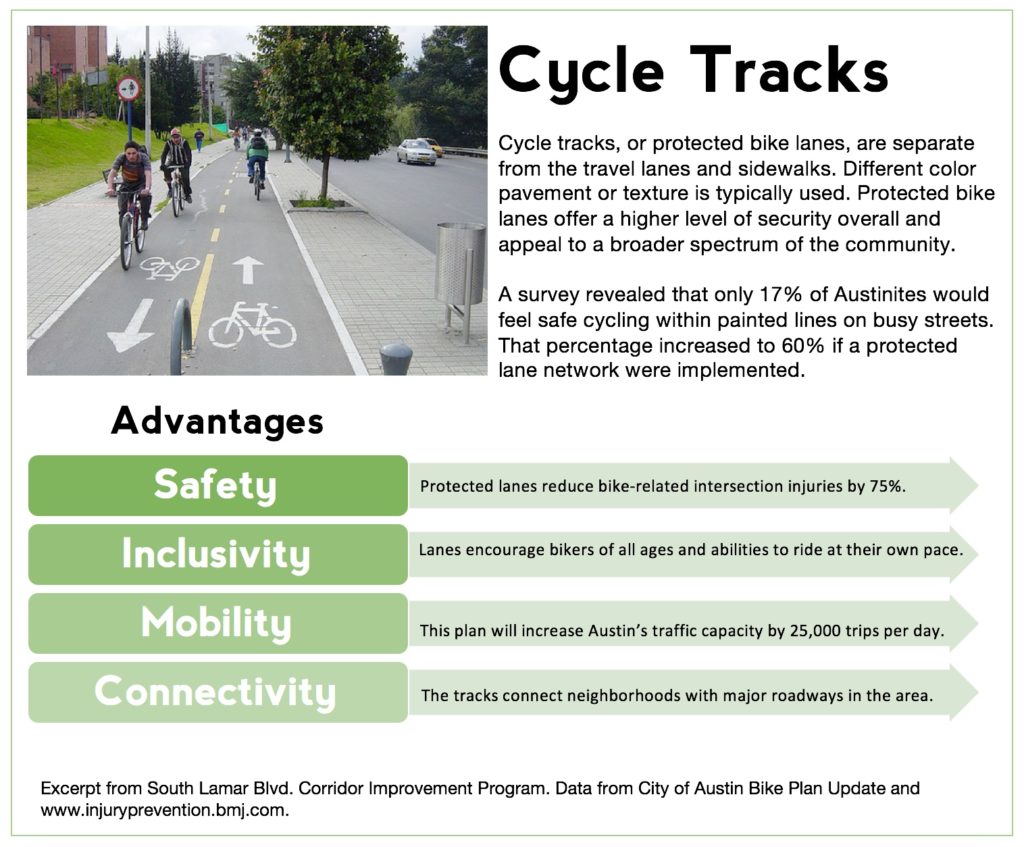 Another way we can help traffic is by building what are called “cycle tracks,” or protected bike paths. There are a lot of ways this helps traffic congestion: First, surveys show that thousands of people in Austin would ride their bikes more if they had safe, protected bike paths, and even if you’re not one of those people the driver in the car in front of you might be. Also, protected lanes reduce bike-related injuries at intersections by 75%, which isn’t just a safety benefit. Collisions are a major source of traffic delays. Finally, if bikes have their own lane, vehicles won’t have to slow down to avoid cyclists.
Another way we can help traffic is by building what are called “cycle tracks,” or protected bike paths. There are a lot of ways this helps traffic congestion: First, surveys show that thousands of people in Austin would ride their bikes more if they had safe, protected bike paths, and even if you’re not one of those people the driver in the car in front of you might be. Also, protected lanes reduce bike-related injuries at intersections by 75%, which isn’t just a safety benefit. Collisions are a major source of traffic delays. Finally, if bikes have their own lane, vehicles won’t have to slow down to avoid cyclists.
Everyone wins by getting where they’re going more quickly and much safer, and we’re improving traffic congestion in a way that makes active transportation a better option for many people. A 2013 study by the City of Austin found that 50% of Austinites would be more likely to bike to work or on errands if they had safe, protected bike paths.
Turning bays and left-turn lanes
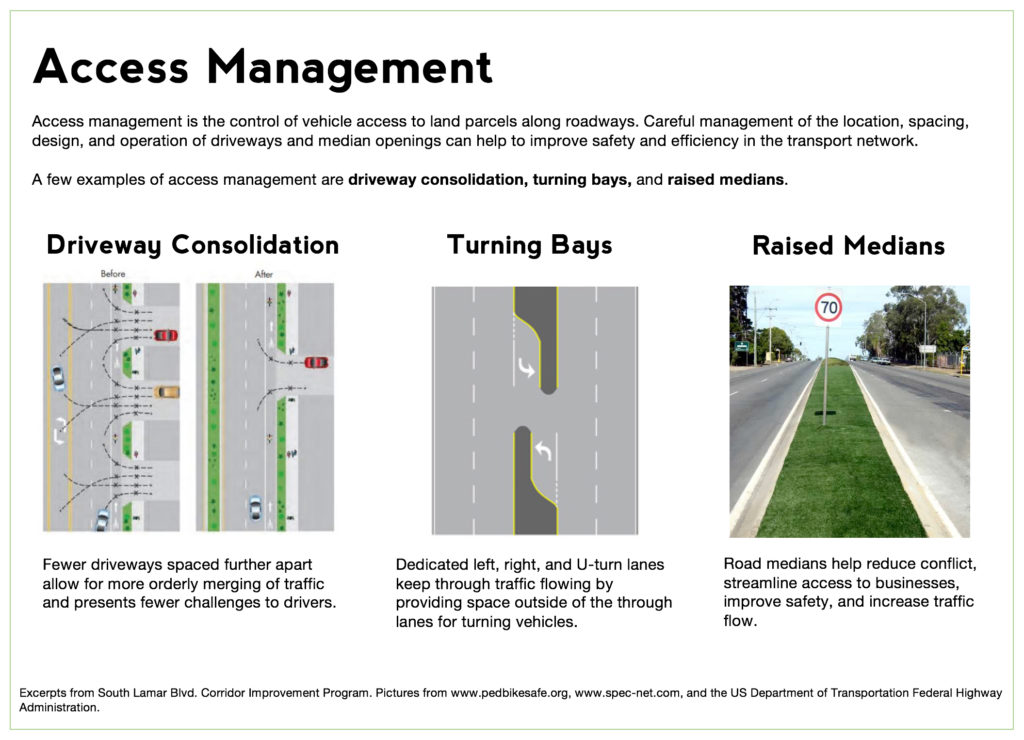
Ever had to stop a few times driving down Lamar or Burnet because someone was turning left mid-block? Getting stuck behind someone turning left isn’t just annoying. It’s a design flaw in an old state highway, but it’s something we can fix by turning it into a Smart Corridor. By limiting the driveways and building dedicated left-turn lanes, we can minimize blockages and increase traffic flow by directing the turning vehicle out of the through lane.
Smart traffic lights & hybrid beacons
We can also make some smart changes when it comes to signalization. First, we can install smart traffic lights. Everyone wants us to time the lights now, but our existing technology is outdated. You know how we time the lights now? We send a city worker out with a stopwatch and a clipboard once every four years to do it by hand. This is not how we should be managing traffic in one of the smartest cities in the world.
The Smart Corridor plan would include funding for new, smarter traffic lights that the Traffic Management Center could adjust remotely. If there is an accident, a flood, a concert letting out, or any other event affecting traffic, we could instantly change the light patters to make our traffic flow better — you know, exactly like you thought the lights worked now.
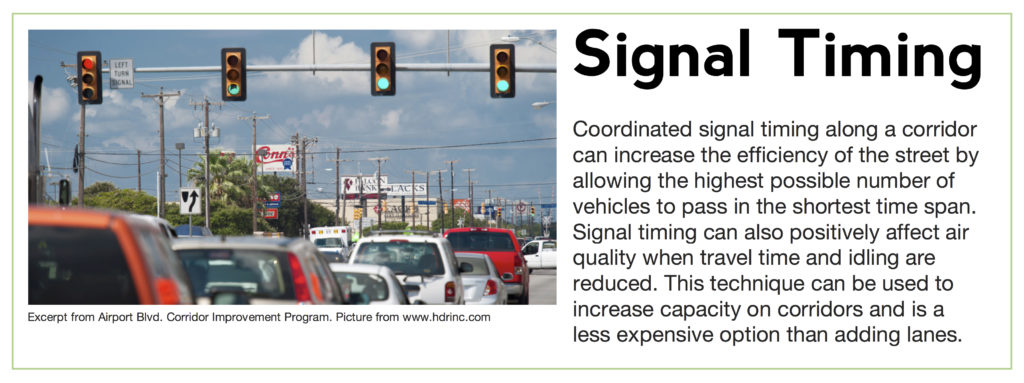
Also, we can install pedestrian hybrid beacons that are already in use in some places around Austin. These make our roads safer by reducing collisions involving pedestrians by 69%, but they also increase traffic flow because they only stop traffic when someone needs to cross the street and not on an automatic cycle.
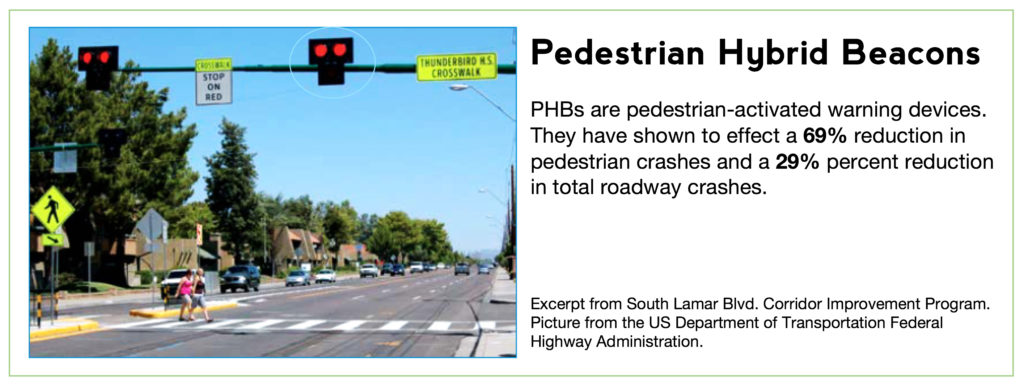
How much would this improve traffic?
It’s important to know that the way we measure the effectiveness of roadways such as these old state highways is to measure delays at intersections. When we talk about traffic congestion on these roads, we talk about delays at intersections. If the intersections work better (as each of the changes described above would do), that means your wait at those intersections is shorter.
Here are some representative examples of what city planners say would happen if we do the Smart Corridor plan:
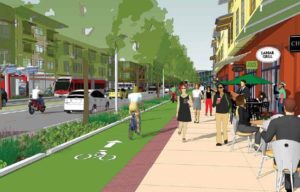 South Lamar: Turning South Lamar into a Smart Corridor would have a profound effect on traffic congestion. If we make the long-term improvements included in the Smart Corridor plan, wait times at intersections during morning rush hour on South Lamar would improve 61%. If we do nothing, wait times at intersections in the mornings will increase 216%.
South Lamar: Turning South Lamar into a Smart Corridor would have a profound effect on traffic congestion. If we make the long-term improvements included in the Smart Corridor plan, wait times at intersections during morning rush hour on South Lamar would improve 61%. If we do nothing, wait times at intersections in the mornings will increase 216%.
In the evening rush hour, wait times at intersections will decrease 51% if we do the long-term projects. If we do nothing, evening rush hour delays will increase 113%.
North Lamar: If we turn North Lamar Boulevard into a Smart Corridor, morning delays at intersections would decrease 48%, and evening delays at intersections would decrease 49%. Comparative data is not yet available.
Burnet Road: If we do the long-term work on Burnet Road, morning delays at intersections would decrease 11% and afternoon rush hour delays would go down 27%. Comparative data is not yet available.
Airport Boulevard: If we do the long-term projects in the Smart Corridor plan, delays at intersections during your morning commute would decrease 10%; if we do nothing, delays will increase 40%.
In evening rush hour, wait times at intersections would decrease 20%; if we do nothing, wait times at those same intersections will increase 40%.
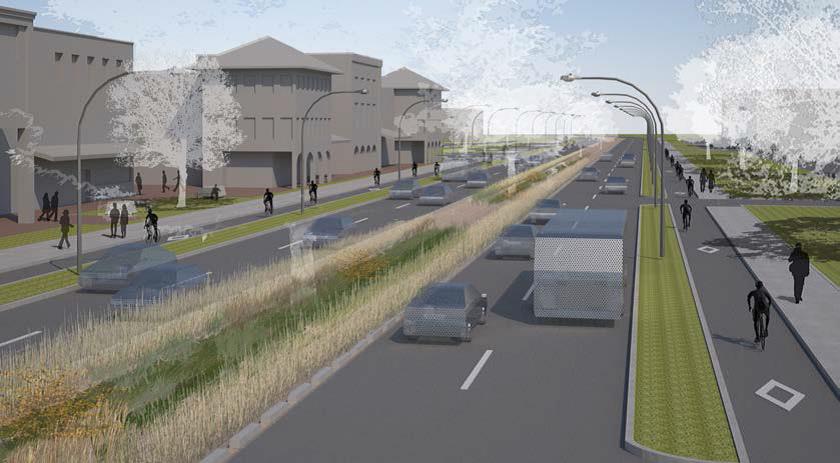
Tumlin Report: Fix the corridors
To fix all of Austin’s mobility problems would cost $8.5 billion. The Smart Corridor plan is where 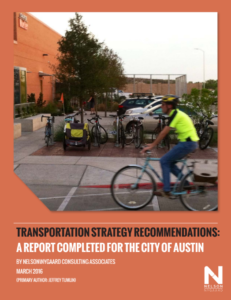 we begin. Jeffrey Tumlim‘s report to the Austin Transportation Department says one of our biggest priorities as a city should be improving our corridors.
we begin. Jeffrey Tumlim‘s report to the Austin Transportation Department says one of our biggest priorities as a city should be improving our corridors.
“Austin has a problem of success. Austin is a thriving city, and its success has resulted in severe traffic congestion,” wrote Tumlin. “Austin’s current success threatens its future.”
Among the eight priorities Tumlin identified was “implement corridor plans with a focus on walkability.”
“The City of Austin has invested great effort in developing several thoughtful corridor and special district plans. … These plans and others establish Austin’s forward-thinking planning, and they are already positively impacting the urban landscape.”
We paid millions of dollars to develop these corridor plans, and right now they’re sitting on a shelf — literally. It’s time to take them down and get to work.

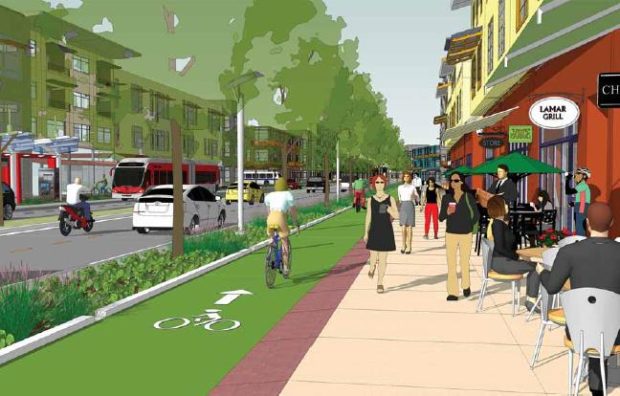
One comment
Comments are closed.